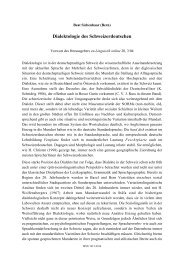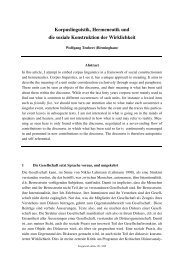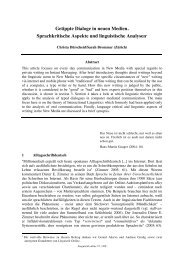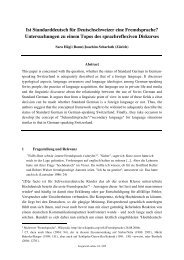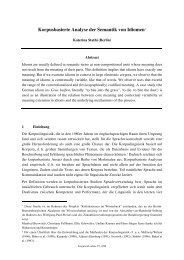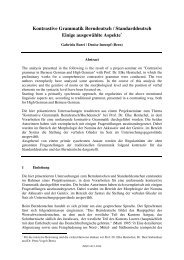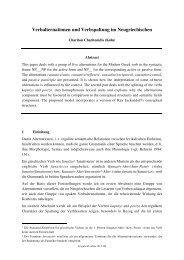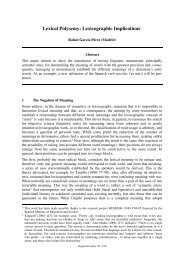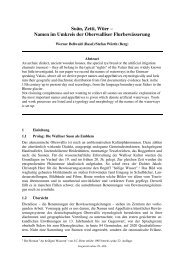84<strong>Linguistik</strong> <strong>on</strong>line 56, 6/12below, the study analyses the opening and closing formulae used in this genre, available bythis fairly recent applicati<strong>on</strong>, in order to observe the degree <str<strong>on</strong>g>of</str<strong>on</strong>g> formality and informality theEnglish language presents in a specific <strong>on</strong>line envir<strong>on</strong>ment. The distincti<strong>on</strong> between nativeand n<strong>on</strong>-native speakers <str<strong>on</strong>g>of</str<strong>on</strong>g> English is also a parameter <str<strong>on</strong>g>of</str<strong>on</strong>g> academic interest.The research presented in this article forms part <str<strong>on</strong>g>of</str<strong>on</strong>g> what could be called the forth step in theresearch <str<strong>on</strong>g>of</str<strong>on</strong>g> computer-mediated communicati<strong>on</strong> (CMC), which deals with the study <str<strong>on</strong>g>of</str<strong>on</strong>g>electr<strong>on</strong>ic discourse in languages other than English, in n<strong>on</strong>-angloph<strong>on</strong>e fora or in n<strong>on</strong>-English-dominant countries, studies <str<strong>on</strong>g>of</str<strong>on</strong>g> special relevance according to Murray (2000). Thestudy <str<strong>on</strong>g>of</str<strong>on</strong>g> the linguistics <str<strong>on</strong>g>of</str<strong>on</strong>g> <strong>Facebook</strong> is especially interesting due to its novelty, widespread useand the importance it is gaining in everyday life.In the specific field <str<strong>on</strong>g>of</str<strong>on</strong>g> English for Academic Purposes, little attenti<strong>on</strong> has been devoted to theimpact <str<strong>on</strong>g>of</str<strong>on</strong>g> the new genres developed by the Internet. The need to examine the changes that thenew <strong>on</strong>line genres imply for academic literacy practices is posed by Hyland/Hamp-Ly<strong>on</strong>s(2002). More recently, Kuteeva (2011) has enhanced the study <str<strong>on</strong>g>of</str<strong>on</strong>g> the new <strong>on</strong>line tools <str<strong>on</strong>g>of</str<strong>on</strong>g>feredby Web 2.0 in more specific c<strong>on</strong>texts, in light <str<strong>on</strong>g>of</str<strong>on</strong>g> the paucity <str<strong>on</strong>g>of</str<strong>on</strong>g> scholarly research realised upto date.2 Materials and Methods2.1 CorpusThe corpus <str<strong>on</strong>g>of</str<strong>on</strong>g> the study has been collected by the author during 2009 and 2010. It comprises300 comments posted to the <str<strong>on</strong>g>of</str<strong>on</strong>g>ficial <strong>Facebook</strong> sites <str<strong>on</strong>g>of</str<strong>on</strong>g> universities in Europe and The UnitedStates <str<strong>on</strong>g>of</str<strong>on</strong>g> America such as the University <str<strong>on</strong>g>of</str<strong>on</strong>g> Southern Denmark, The University <str<strong>on</strong>g>of</str<strong>on</strong>g> Edinburgh,The University <str<strong>on</strong>g>of</str<strong>on</strong>g> Manchester, The University <str<strong>on</strong>g>of</str<strong>on</strong>g> Oxford, The University <str<strong>on</strong>g>of</str<strong>on</strong>g> Warwick, FloridaState University, Ohio State University, The University <str<strong>on</strong>g>of</str<strong>on</strong>g> Harvard, The University <str<strong>on</strong>g>of</str<strong>on</strong>g> Texas,and The University <str<strong>on</strong>g>of</str<strong>on</strong>g> Washingt<strong>on</strong>. All the texts studied have been written and posted <strong>on</strong> the<str<strong>on</strong>g>of</str<strong>on</strong>g>ficial sites <str<strong>on</strong>g>of</str<strong>on</strong>g> the universities menti<strong>on</strong>ed. The reas<strong>on</strong> why these sites have been chosen is,firstly, because they are freely accessed sites open to the whole <strong>on</strong>line community, that is, nomember registrati<strong>on</strong> is needed to access the site; sec<strong>on</strong>dly, the language <str<strong>on</strong>g>of</str<strong>on</strong>g> communicati<strong>on</strong> <strong>on</strong>these sites is mostly English.Some c<strong>on</strong>siderati<strong>on</strong>s about free access and privacy matters should be nuanced. Although theaccess <str<strong>on</strong>g>of</str<strong>on</strong>g> these sites is free, no authentic private informati<strong>on</strong> is published in the examplesprovided in this study. Private pers<strong>on</strong>al informati<strong>on</strong> <strong>on</strong> the comments has been modified,keeping similarities with the original as a pro<str<strong>on</strong>g>of</str<strong>on</strong>g> <str<strong>on</strong>g>of</str<strong>on</strong>g> the authenticity <str<strong>on</strong>g>of</str<strong>on</strong>g> the written word, inaccordance with the publicati<strong>on</strong> <str<strong>on</strong>g>of</str<strong>on</strong>g> early collecti<strong>on</strong>s <str<strong>on</strong>g>of</str<strong>on</strong>g> letters (cf. Gurkin 1986). Authenticityhas been a c<strong>on</strong>troversial issue since Medieval England as a criteri<strong>on</strong> <str<strong>on</strong>g>of</str<strong>on</strong>g> source <str<strong>on</strong>g>of</str<strong>on</strong>g> authority inwriting since the authority <str<strong>on</strong>g>of</str<strong>on</strong>g> a text depended not <strong>on</strong>ly <strong>on</strong> intrinsic worth but also <strong>on</strong>authenticity; the criteri<strong>on</strong> demanded that the author be identifiable (cf. Bar<strong>on</strong> 2000). In thelast decade, the issue has gained importance in some areas such as sociolinguistics andanthropological studies (see, for example, Coupland 2003). As for computer-mediatedcommunicati<strong>on</strong>, in this research it is necessary to focus <strong>on</strong> Bar<strong>on</strong>'s (2000) proposals when shepoints out that in <strong>on</strong>line writing the traditi<strong>on</strong>al boundary between author and audience mergesand "the noti<strong>on</strong>s <str<strong>on</strong>g>of</str<strong>on</strong>g> authority, resp<strong>on</strong>sibility, and ownership tend to crumble" (Bar<strong>on</strong> 2000:93). On <strong>Facebook</strong>, the platform allows users to decide what informati<strong>on</strong> about themselvesthey want to share with others; it is not to change identities but to present the best part <str<strong>on</strong>g>of</str<strong>on</strong>g> theuser to the others (cf. Bar<strong>on</strong> 2008). In this research, the presentati<strong>on</strong> <str<strong>on</strong>g>of</str<strong>on</strong>g> self is not questi<strong>on</strong>edor analysed, this could be a research topic in another study 1 . Thus, the informati<strong>on</strong> publishedby participants <strong>on</strong> their pr<str<strong>on</strong>g>of</str<strong>on</strong>g>iles c<strong>on</strong>cerning place <str<strong>on</strong>g>of</str<strong>on</strong>g> birth, place <str<strong>on</strong>g>of</str<strong>on</strong>g> living, and languages1 See Marwick (2005) for a study <strong>on</strong> authenticity and social networking.ISSN 1615-3014
Carmen Pérez-Sabater:The linguistics <str<strong>on</strong>g>of</str<strong>on</strong>g> social networking: A study <str<strong>on</strong>g>of</str<strong>on</strong>g> writing c<strong>on</strong>venti<strong>on</strong>s <strong>on</strong> <strong>Facebook</strong>85known, has been regarded as an authentic source <str<strong>on</strong>g>of</str<strong>on</strong>g> informati<strong>on</strong> to distinguish between nativespeakers <str<strong>on</strong>g>of</str<strong>on</strong>g> English and n<strong>on</strong>-native. In CMC the distincti<strong>on</strong> between native and n<strong>on</strong>-nativec<strong>on</strong>texts is a parameter <str<strong>on</strong>g>of</str<strong>on</strong>g> importance for authors like Lan (2000), Li (2000) and Ancarno(2005), am<strong>on</strong>g others. The difference between native and n<strong>on</strong>-native speakers <str<strong>on</strong>g>of</str<strong>on</strong>g> Englishalways refers to the author <str<strong>on</strong>g>of</str<strong>on</strong>g> the written comment. The number <str<strong>on</strong>g>of</str<strong>on</strong>g> native and n<strong>on</strong>-nativecomments analysed is equal, 150 in each category, following the suggesti<strong>on</strong>s <str<strong>on</strong>g>of</str<strong>on</strong>g> Rowe (2008).Lastly, as for the number <str<strong>on</strong>g>of</str<strong>on</strong>g> comments chosen, 300 posts was the work load the author couldhandle manually, since no s<str<strong>on</strong>g>of</str<strong>on</strong>g>tware aided analysis <str<strong>on</strong>g>of</str<strong>on</strong>g> language could be used for this research.2.2 Methodological c<strong>on</strong>siderati<strong>on</strong>s2.2.1 Methodological frameworkThe drift towards orality in the English language use posited by eminent scholars such asLeech (1966), Biber and Finegan (1989), and Fairclough (1992) has also been <str<strong>on</strong>g>of</str<strong>on</strong>g> interest incomputer-mediated communicati<strong>on</strong> (e. g. Bar<strong>on</strong> 2000). Some parameters have been used tomeasure the degree <str<strong>on</strong>g>of</str<strong>on</strong>g> orality and informality in the new electr<strong>on</strong>ic genres, like the number <str<strong>on</strong>g>of</str<strong>on</strong>g>words per sentence, the use <str<strong>on</strong>g>of</str<strong>on</strong>g> paralinguistic cues, informal language, spelling mistakes andcourtesy formulae (e. g. Pérez-Sabater et al. 2008b).Following the studies <strong>on</strong> email by Gains (1999), Bar<strong>on</strong> (2000), Waldvogel (2007), and Bou-Franch (2011), this research will examine the presence <str<strong>on</strong>g>of</str<strong>on</strong>g> the formulae <str<strong>on</strong>g>of</str<strong>on</strong>g> etiquette andprotocol used for salutati<strong>on</strong>, opening, pre-closing and closing in comments published <strong>on</strong> thesocial networking site <strong>Facebook</strong>. The findings will be compared with the results obtained inthis parameter in other studies <str<strong>on</strong>g>of</str<strong>on</strong>g> computer mediated communicati<strong>on</strong> discourse alreadypublished <strong>on</strong> other CMC genres widely used in the university such as email and <strong>on</strong>lineforums.Openings and closings, "the most salient structural features <str<strong>on</strong>g>of</str<strong>on</strong>g> an email" (Pérez-Sabater et al.:2008a), are norms developed to structure and regulate c<strong>on</strong>versati<strong>on</strong>s (cf. Murray 2000). Bar<strong>on</strong>(2000) points out that although salutati<strong>on</strong>s and farewells tend to be sparse in emails as thename <str<strong>on</strong>g>of</str<strong>on</strong>g> the sender and addressee are known, c<strong>on</strong>venti<strong>on</strong>s have evolved to open and closemessages. Danet (2002) underlines the redundancy <str<strong>on</strong>g>of</str<strong>on</strong>g> including these salutati<strong>on</strong>s and closingsas they appear at the top <str<strong>on</strong>g>of</str<strong>on</strong>g> the email. Other scholars also c<strong>on</strong>sider these elements as opti<strong>on</strong>alin emails, and therefore valuable for empirical research (cf. Bou-Franch 2011). On <strong>Facebook</strong>,in some cases the inclusi<strong>on</strong> <str<strong>on</strong>g>of</str<strong>on</strong>g> greetings and farewells may also be redundant and, therefore,<str<strong>on</strong>g>of</str<strong>on</strong>g> research value, in some other situati<strong>on</strong>s, these strategies may be necessary to work out thecurrent message's propositi<strong>on</strong>al meaning.2.2.2 Method <str<strong>on</strong>g>of</str<strong>on</strong>g> studyTo assess the formality or informality <str<strong>on</strong>g>of</str<strong>on</strong>g> the messages, the proposals <str<strong>on</strong>g>of</str<strong>on</strong>g> Pearce (2005),Duthler (2006) and the author's previous research (Pérez-Sabater et al. 2008a) are followed.Phatic communicati<strong>on</strong> in the form <str<strong>on</strong>g>of</str<strong>on</strong>g> greetings and farewell formulae have been studiedaccording to the criteria established after an initial examinati<strong>on</strong> <str<strong>on</strong>g>of</str<strong>on</strong>g> the corpus, where the usualrange <str<strong>on</strong>g>of</str<strong>on</strong>g> formulae from traditi<strong>on</strong>al letter writing is employed in some cases, while, in others,there is no use <str<strong>on</strong>g>of</str<strong>on</strong>g> these courtesy formulae. In this quantitative study, the corpus has beenanalysed following a scale ranging from "very formal" greetings and farewells to "veryinformal", using the criteria shown in Table 1. In this study, we associate the use <str<strong>on</strong>g>of</str<strong>on</strong>g>c<strong>on</strong>versati<strong>on</strong>al traits in written texts to informality, while formality is related to n<strong>on</strong>c<strong>on</strong>versati<strong>on</strong>aland impers<strong>on</strong>al registers (cf. Biber et al. 2002).Thus, greetings beginning with Dear Mr/Dr + sec<strong>on</strong>d name are c<strong>on</strong>sidered very formal, Dear+ first name formal, Hello + name informal and Hi, Hey or a name very informal. Similarly,ISSN 1615-3014



